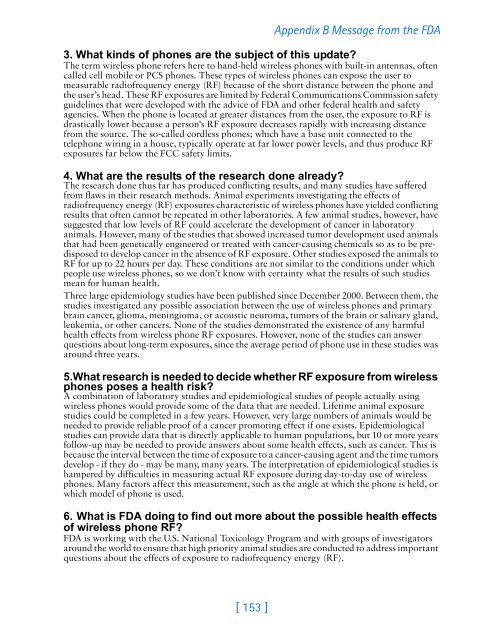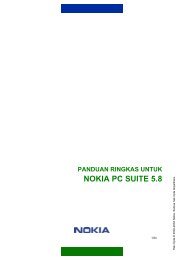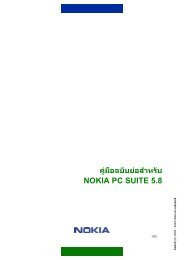Nokia 3360 User's Guide
Nokia 3360 User's Guide
Nokia 3360 User's Guide
Create successful ePaper yourself
Turn your PDF publications into a flip-book with our unique Google optimized e-Paper software.
[ 153 ]<br />
Appendix B Message from the FDA<br />
3. What kinds of phones are the subject of this update?<br />
The term wireless phone refers here to hand-held wireless phones with built-in antennas, often<br />
called cell mobile or PCS phones. These types of wireless phones can expose the user to<br />
measurable radiofrequency energy (RF) because of the short distance between the phone and<br />
the user’s head. These RF exposures are limited by Federal Communications Commission safety<br />
guidelines that were developed with the advice of FDA and other federal health and safety<br />
agencies. When the phone is located at greater distances from the user, the exposure to RF is<br />
drastically lower because a person's RF exposure decreases rapidly with increasing distance<br />
from the source. The so-called cordless phones; which have a base unit connected to the<br />
telephone wiring in a house, typically operate at far lower power levels, and thus produce RF<br />
exposures far below the FCC safety limits.<br />
4. What are the results of the research done already?<br />
The research done thus far has produced conflicting results, and many studies have suffered<br />
from flaws in their research methods. Animal experiments investigating the effects of<br />
radiofrequency energy (RF) exposures characteristic of wireless phones have yielded conflicting<br />
results that often cannot be repeated in other laboratories. A few animal studies, however, have<br />
suggested that low levels of RF could accelerate the development of cancer in laboratory<br />
animals. However, many of the studies that showed increased tumor development used animals<br />
that had been genetically engineered or treated with cancer-causing chemicals so as to be predisposed<br />
to develop cancer in the absence of RF exposure. Other studies exposed the animals to<br />
RF for up to 22 hours per day. These conditions are not similar to the conditions under which<br />
people use wireless phones, so we don’t know with certainty what the results of such studies<br />
mean for human health.<br />
Three large epidemiology studies have been published since December 2000. Between them, the<br />
studies investigated any possible association between the use of wireless phones and primary<br />
brain cancer, glioma, meningioma, or acoustic neuroma, tumors of the brain or salivary gland,<br />
leukemia, or other cancers. None of the studies demonstrated the existence of any harmful<br />
health effects from wireless phone RF exposures. However, none of the studies can answer<br />
questions about long-term exposures, since the average period of phone use in these studies was<br />
around three years.<br />
5.What research is needed to decide whether RF exposure from wireless<br />
phones poses a health risk?<br />
A combination of laboratory studies and epidemiological studies of people actually using<br />
wireless phones would provide some of the data that are needed. Lifetime animal exposure<br />
studies could be completed in a few years. However, very large numbers of animals would be<br />
needed to provide reliable proof of a cancer promoting effect if one exists. Epidemiological<br />
studies can provide data that is directly applicable to human populations, but 10 or more years<br />
follow-up may be needed to provide answers about some health effects, such as cancer. This is<br />
because the interval between the time of exposure to a cancer-causing agent and the time tumors<br />
develop - if they do - may be many, many years. The interpretation of epidemiological studies is<br />
hampered by difficulties in measuring actual RF exposure during day-to-day use of wireless<br />
phones. Many factors affect this measurement, such as the angle at which the phone is held, or<br />
which model of phone is used.<br />
6. What is FDA doing to find out more about the possible health effects<br />
of wireless phone RF?<br />
FDA is working with the U.S. National Toxicology Program and with groups of investigators<br />
around the world to ensure that high priority animal studies are conducted to address important<br />
questions about the effects of exposure to radiofrequency energy (RF).

















